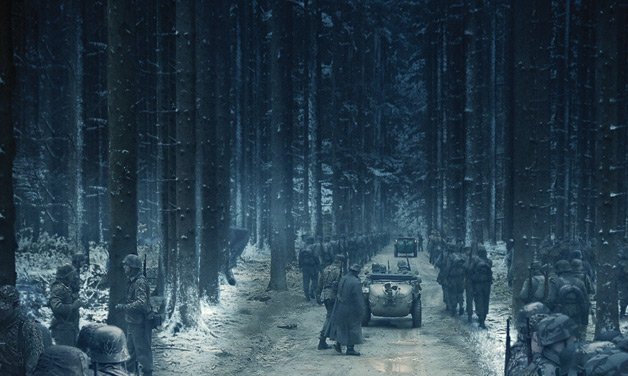
The Wereth Eleven
A docudrama about 11 black U.S. soldiers who were tortured and killed during the Battle of the Bulge is still attracting attention, nearly a year after winning the Founder’s Choice Award at the 2011 GI Film Festival in Washington. The festival receives promotional support from The American Legion.
“The Wereth Eleven” tells a story that’s been largely forgotten, except for the soldiers’ families and citizens of the Belgian town where the murders took place. The all-black 333rd Field Artillery Battalion landed at Utah Beach on June 29, 1944. When the Germans began shelling the village of Schönberg, Belgium, on Dec. 16, the unit was overrun. Those who weren’t killed were forced to surrender, with most ending up in prison camps for the remainder of the war. A truck full of soldiers from the 333rd managed to evacuate, but eventually it was stopped by German forces, and its passengers taken prisoner. Strafing gunfire by U.S. planes allowed some of the soldiers to slip away, and they met other escapees in the woods.
The Wereth 11 walked 10 miles through heavy snow to the hamlet of Wereth, in a part of Belgium that had belonged to Germany until World War I. The soldiers stopped at the first of nine houses, where a farmer took them in. Unable to speak English, he couldn’t tell them how to get to safety. Meanwhile, a Nazi sympathizer alerted the head of an SS division, and within hours, German officers were at the door. The 11 soldiers surrendered and were marched down the road, where they were maimed, killed and mutilated.
Their bodies were left undisturbed in a ditch for weeks, until the people of Wereth found them and directed the U.S. military to the site. Seven of the men were laid to rest in the Henri-Chapelle American Cemetery in Belgium, and four were returned to their families for burial.
The same German division that captured the Wereth 11 committed other atrocities, but the incident was left off the final list of war crimes for reasons not entirely clear even today. But local residents – including Herman Langer, whose father, Mathius, sheltered the Wereth 11 – haven’t forgotten. In 2004, they dedicated the U.S. Wereth Memorial, believed to be the only memorial to black GIs of World War II in Europe.
The tale of the Wereth 11 has long captured the imagination of Joseph Small, who served as the film’s executive producer. “I was really moved and saddened by this story,” he says. “I thought that the men’s dignity was taken from them, and that really bothered me. I set out on a mission to make sure the citizens of America and Europe knew what happened to those 11 men, and to make sure they knew the contribution of the 333rd Field Artillery Battalion during World War II.”
Small’s collaborators were writer/director Rob Child and editor Frederic Lumiere, who directed and produced the History Channel miniseries “WWII in HD.” He shot the film in Belgium and Maryland, and calls it “the best experience of my life. Everything fell into place – permission from the landowner in Belgium to film there, as well as the local mayor. Every piece of equipment we needed or desired for authenticity, we got. The Army commanders in Germany were a tremendous help and gave the story legitimacy. The Belgians were wonderful, and we remain close friends.”
In Maryland, the young men portraying the 11 soldiers worked three days in 100-degree heat without complaint, lying still in uniforms made of wool. “I tried to call the shoot three times, but they waved me off and said they were fine, out of respect and honor to the soldiers,” Small says.
Child says he was determined to give “The Wereth Eleven” the feeling of a large-scale production, despite its less-than-large-scale budget. Through computer-generated effects and clever editing, Child succeeded in using “a limited number of actors to create huge scenes.” And it wasn’t just the actors who had to be manipulated. “We filmed from May to July, and it had to look like December,” Child adds. The film has a blue-gray tint to convey the battle’s cold weather.
The film weaves together scenes of Small and two descendants of the 333rd soldiers at the site of the massacre, along with re-enactments and comments from George Shomo, a staff sergeant in the 333rd and a POW. The actors portraying the Wereth 11 are members of the U.S. military stationed in Germany. Child says the story “had a great impact on their performances. They felt like they were representing African-American history. Every take, they gave it their all.”
Lumiere says the bluescreen and post-production editing process “is almost like a video game. It reminded me of playing with those little green GIs when I was a kid.” An extra feature on the film’s DVD, “The Wereth 11 Exposed,” shows how all the film’s elements, real and computer-generated, came together. “All the rules of great storytelling apply,” even with great production, he adds. Lumiere attended a screening of the film in Wereth, and says it got an “incredible reception. There’s a true love and true appreciation for Americans there ... it’s still very much alive today.”
In addition to receiving the GI Film Festival’s Founder’s Award, “The Wereth Eleven” and its editor received a nomination in the Outstanding Editing-Television category of the 2011 Hollywood Post Alliance Awards. As for Small, he’s finished a new film, “The Franklin – Honor Restored,” and is an executive producer of the coming World War II feature film “No Better Place to Die.”
Of the Wereth 11, he says, “I wanted to honor these men by showing just how skilled they were, and simply portray them as 11 American soldiers who belonged to the 333rd Field Artillery Battalion, which fought with distinction, honor and incredible bravery since the day they landed on Utah Beach.”
Laura Edwards is assistant editor of The American Legion Magazine.
